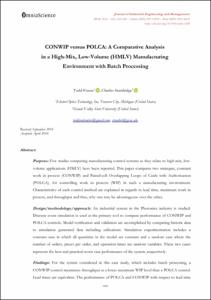CONWIP versus POLCA: a comparative analysis in a High-Mix, Low-Volume (HMLV) manufacturing environment with batch processing

Visualitza/Obre
Cita com:
hdl:2117/88997
Tipus de documentArticle
Data publicació2016-06
EditorOmnia Science
Condicions d'accésAccés obert
Llevat que s'hi indiqui el contrari, els
continguts d'aquesta obra estan subjectes a la llicència de Creative Commons
:
Reconeixement-NoComercial 3.0 Espanya
Abstract
Purpose: Few studies comparing manufacturing control systems as they relate to high-mix, lowvolume
applications (HMLV) have been reported. This paper compares two strategies, constant
work in process (CONWIP) and Paired-cell Overlapping Loops of Cards with Authorization
(POLCA), for controlling work in process (WIP) in such a manufacturing environment.
Characteristics of each control method are explained in regards to lead time, maximum work in
process, and throughput and thus, why one may be advantageous over the other.
Design/methodology/approach: An industrial system in the Photonics industry is studied.
Discrete event simulation is used as the primary tool to compare performance of CONWIP and
POLCA controls. Model verification and validation are accomplished by comparing historic data
to simulation generated data including utilizations. Simulation experimentation includes a
constant case in which all quantities in the model are constant and a random case where the
number of orders, pieces per order, and operation times are random variables. These two cases
represent the best and practical worst case performance of the system, respectively.
Findings: For the system considered in this case study, which includes batch processing, a
CONWIP control maximizes throughput at a lower maximum WIP level than a POLCA control.
Lead times are equivalent. The performance of POLCA and CONWIP with respect to lead time and throughput becomes equivalent for higher levels of WIP. This is true for both the constant
and random cases.
Practical implications: The POLCA control strategy uses multiply parameters that in effect
specify the maximum WIP in specific areas of the system whereas the CONWIP control is
simpler, using a single parameter to specify the upper bound on the overall WIP in the
system. In other words, POLCA can potentially prevent all the allowed WIP from
congregating in one area of the system and thus preventing relatively large lead times whereas
CONWIP does not. In this case, the more detailed control provided by the POLCA system
was shown to be unnecessary as the simpler CONWIP control was sufficient. This appears to
be due to the batch processing operations and the relatively low utilization of many of the
operations.
Originality/value: The study compliments and extends previous studies comparing CONWIP
and POLCA performance to a HMLV manufacturing environment with batch operations. It
demonstrates the utility of discrete event simulation. It shows how to evaluate trade-offs between
the single parameter CONWIP control strategy and the multi-parameter POLCA control strategy
with regard to maximum WIP, throughput, and lead time.
CitacióFrazee, Todd; Standridge, Charles Robert. CONWIP versus POLCA: a comparative analysis in a High-Mix, Low-Volume (HMLV) manufacturing environment with batch processing. "Journal of Industrial Engineering and Management", Juny 2016, vol. 9, núm. 2, p. 432-449.
Dipòsit legalB-28744-2008
ISSN2013-0953
| Fitxers | Descripció | Mida | Format | Visualitza |
|---|---|---|---|---|
| 1248-8716-1-PB.pdf | 992,5Kb | Visualitza/Obre |


